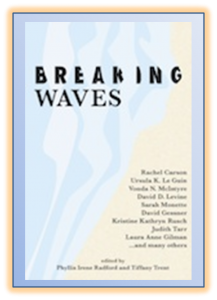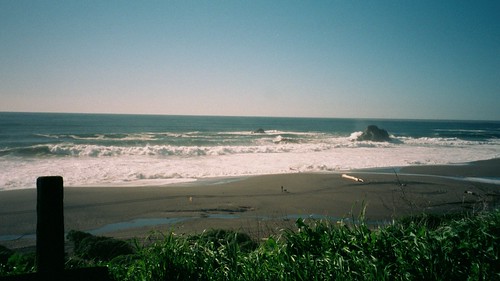…The face of the sea is always
changing. Crossed by
colors, lights, and moving shadows,
sparkling in the sun, mysterious
in the twilight, its aspects
and its moods vary hour by hour.
The surface waters move
with the tides, stir to the breath
of the winds, and rise and fall
to the endless, hurrying
forms of the waves.
~ Rachel Carson, from The Sea Around Us
We’re beach people. We’re of that Northern California breed who simply cannot live too far inland, who cringe at the thought of life without an ocean nearby. Massive rocks and booming surf? Freezing waves? That’s the beach to us. (This to differentiate “beach” from the Southern Californian understanding which actually includes sand and getting into the water sans wetsuit. For behold, there they fear not undertow nor riptide, nor sharks, nor hypothermia… lucky buggers. But we like our cold mean shores.) And it sickened us, and continues to, as we continue to hear of the tremendous toll taken on the waters of the Gulf. Not our waves, no. Not our concept of “beach.” But it’s hard to hear, hard to bear knowing that not only have decades worth of livelihoods and millions of animals perished in the gush of oil, but quiet places for peace – which we all need so badly – are destroyed and diminished.
So, when we heard that our friend Kelly was part of BREAKING WAVES, we were doubly glad – first because she’s an amazing poet, second because she’s a perfectly wonderful human being (with whom T. has been “blog buddies” for about three years, and whom she met in person for the first time this past June at the ALA Convention). We’re very proud to do a little commercial for Breaking Waves.
Breaking Waves, edited by Tiffany Trent and Phyllis Irene Radford, is a collection of 34 poems, memoirs, short stories, and articles (including an excerpt from Rachel Carson’s The Sea Around Us). It sells for $4.99 U.S., and all proceeds go 100% to the Gulf Coast Oil Spill Fund of the Greater New Orleans Foundation – which spreads donations between organizations that help fishermen and their families, with not only direct assistance to the local fishing families but also funding to the SPCA, environmental monitoring via the “Bucket Brigade” and more.
The book begins with a poem by Ursula K. Leguin (if you have any sci-fi geekatude, this is exciting), and ends with Kelly’s poem, “Troubled Water.” The work in between, by writers and poets from various genres, varies, but all come back to the sea. The collection is hosted at Book View Cafe, and downloadable in DRM-Free formats: epub, mobi, pdf, prc.
What’s that saying? “Where there’s life, there’s hope?” More from Rachel Carson’s The Sea Around Us:
…But the symbols of hope are not lacking
even in the grayness and bleakness of the winter sea.
On land we know that the apparent lifelessness of winter
is an illusion. Look closely at the bare branches of a tree,
on which not the palest gleam of green can be discerned.
Yet spaced along each branch are the leaf buds,
all the spring’s magic of swelling green concealed
and safely preserved under the insulating, overlapping layers.
Pick off a piece of the rough bark of the trunk;
there you will find hibernating insects.
Dig down through the snow into the earth.
There are the eggs of next summer’s grasshoppers;
there are the dormant seeds from which will come
the grass, the herb, the oak tree.
So, too, the lifelessness, the hopelessness, the despair
of the winter sea are an illusion.
Everywhere are the assurances that the cycle has come
to the full, containing the means of its own renewal.
There is the promise of a new spring in the very iciness
of the winter sea, in the chilling of the water,
which must, before many weeks, become so heavy
that it will plunge downward, precipitating the overturn
that is the first act in the drama of spring.
There is the promise of new life in the small plantlike things
that cling to the rocks of the underlying bottom,
the almost formless polyps from which, in spring,
a new generation of jellyfish will bud off and rise
into the surface waters. There is unconscious purpose
in the sluggish forms of the copepods hibernating
on the bottom, safe from the surface storms,
life sustained in their tiny bodies by the extra store
of fat with which they went into this winter sleep…
Thus ends our commercial break. Thanks for reading.
It is always better to do a small thing than nothing at all.



oh–will definitely have to get this book!